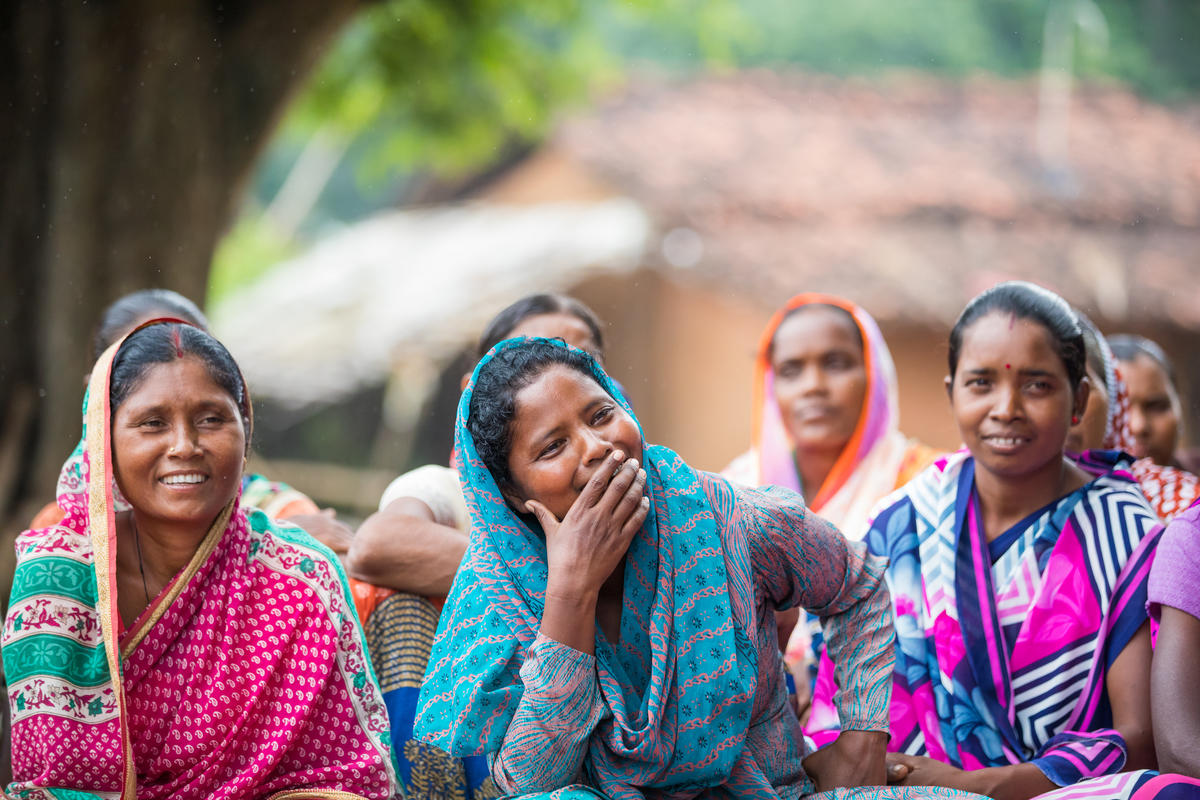
Self help group members in discussion with foundation staff and Professional Assistance for Development Action (PRADAN) staff during a meeting in Sondari Pakartoli village, Torpa, Jharkhand, India on August 28, 2018.
Photo credit: ©Gates Archive/Mansi Midha
Since the 1980s, India has invested significantly in Self-Help Groups (SHGs) and other women’s groups to improve gender equality and women’s empowerment. Most prominently, the National Rural Livelihoods Mission (NRLM) aims to mobilise 70 million households into SHGs. Modelled after the Society for Elimination of Rural Poverty programme in Andhra Pradesh, the NRLM is the largest women’s group initiative in the world, and 3ie is currently implementing an impact evaluation of the programme. (For an on-the-ground look at the work 3ie is doing to study the program, click here.)
Economic SHGs start with an initial period, typically six months, of women saving collectively to facilitate intragroup lending. After that, SHG members can gradually take larger loans from banks or other institutions. Economic SHGs generally offer women collective finance (for example, savings, loans, and insurance, increasingly in combination with enterprise and/or livelihood services). Livelihood interventions can include life skills training, business training, financial education, and organisation-building for labour and trade groups.
So, does participation in SHGs empower women? A recently published 3ie report provides some answers by summarising the findings of a systematic review on the effects of economic self-help group programs on women’s empowerment. The review includes evidence from 34 SHGs from South Asia, East Asia, Latin America and the Caribbean and Sub-Saharan Africa. A majority (18) of the included studies cover India.
Overall, the systematic review shows that economic self-help group programmes are a promising approach to achieve positive effects on women’s empowerment. On average, participation in SHGs led to a higher ability of women to exert control over resources (economic empowerment), participate in decision-making focused on access to resources, rights and entitlements within communities (political empowerment), make decisions about the reproductive health in the household and increased mobility. Economic SHG programmes that included a training component showed larger effects on women’s economic and reproductive empowerment. However, the quantitative evidence synthesis did not show positive effects on psychological empowerment measures such as self-confidence.
Scaling up economic SHGs to bolster women’s empowerment and well-being
Governments and donors are scaling up women's SHGs in India and elsewhere. The Nigeria for Women project aims to reach 324,000 women across six states using Women’s Affinity Groups. In Uganda, the sustainable livelihood sub-component of the Northern Ugandan Social Action Fund (NUSAF 3) was piloted in 9 districts.
Research on the results of the scaling of SHGs presents mixed results. In particular, an impact evaluation of the Bihar state NRLM (JEEViKA) programme suggests a trade-off between depth and breadth of the programme. The midline results of this evaluation showed some positive effects on women’s empowerment, but the endline results — from after the program had expanded — show much smaller impacts. Qualitative research suggests that these reductions in effectiveness may have been caused by reduced programme intensity after the pace and scale of implementation expanded. Other factors may also have contributed to dissipation of effects. Evidence from other types of interventions also shows that smaller effects of programmes moving to scale are not unique to SHGs. For example, a systematic review of farmer field schools showed that programmes delivered at national scale did not show positive effects two years after they started, despite positive impacts on agricultural yields and income for pilot programmes.
Generate more evidence to understand the benefits of women’s groups at scale
Women’s groups implemented at scale can also achieve benefits through different pathways than pilot programmes. For example, the JEEVIKA SHG programme in Bihar reduced the interest rates charged by informal money lenders, particularly for landless households, due to reduced demand for informal credit. The programme produced this result even though it did not yield positive effects on expenditures and productive asset ownership, with the exception of landless households. Spillover effects like reduced interest rates are more plausible for programmes operating at a larger scale.
Clearly, major evidence gaps remain despite the promising results from the systematic review on economic self-help group programmes. Emerging evidence on the effects of women’s groups is promising but mixed, so more evidence is needed about their impacts at scale.
To address these and other evidence gaps, the Bill & Melinda Gates Foundation set up the Evidence Consortium on Women’s Groups (ECWG), which aims to strengthen, expand, and disseminate the global evidence base on women’s groups. The ECWG has developed a learning agenda on the impact, cost-effectiveness, and implementation of women’s groups operating at scale in India, Nigeria, and Uganda. Both the costs and the implementation of women’s groups are critical to understand before moving programmes to scale, and evidence on these is scant. Where evidence on costs and cost-effectiveness does exist, most of it is based in India, with almost none coming from sub-Saharan Africa.
The systematic review summary report as well as other systematic reviews also note the importance of — but lack of information on — group characteristics, implementation models, and intervention processes. Evaluation evidence generally fails to describe groups’ governance structures, incentive structures for facilitators and community mobilizers, and integration with other services, such as entitlement schemes and social protection programs.
While the systematic review on the effects of economic self-help groups provides essential evidence on the impact of SHGs on women’s empowerment, decision-makers need more evidence on how to successfully implement these programmes at scale. Investing in evidence on costs and implementation of SHGs and women’s groups could go a long way in understanding how these programmes can lead to women’s empowerment and well-being, both in India and in sub-Saharan Africa.
Note: This blog was first published on 3ie's website, as part of an ongoing campaign 2020 Hindsight. Read more about the campaign here.